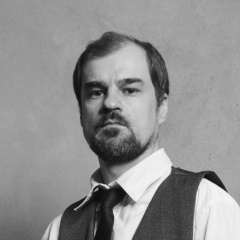Сегодня увидел фотосессию ежедневного парада немцев в оккупированном Париже. В замечательном нуарном фильме 1968 года о французском движении Сопротивления "Армия теней" есть вводная сцена - по омертвелому Парижу возле Триумфальной арки без французского флага проходит парадом колонна немецких солдат с оркестром. Напоминание режиссера Жана-Пьера Мельвиля зрителям о ежедневном позоре их столицы, напоминание от немцев - кто в этом городе хозяин. И как сцена в фильме точно передает статику фотографий!
В романе Ларри Коллинза и Доминика Лапьера "Горит ли Париж?" описан этот ритуал оккупантов:
"Ровно в полдень, как, собственно, каждый день в течение этих четырех лет, рядовой Фриц Готтшальк и 249 других солдат из 1-го зихерунгсрегимента начали свой обычный марш по Елисейским полям до площади Согласия. Впереди духовой оркестр разразился визгливыми нотами марша «Прюссенс глори» — «Прусская слава». Лишь парижане, стоявшие на тротуарах этого величественного проспекта, наблюдали старания рядового Готтшалька. Они уже давно научились избегать этих унизительных зрелищ.
Подобные надменные парады были лишь одним из многих унижений, которым подвергалась столица Франции с 15 июня 1940 года. В те дни единственным местом в Париже, где французы могли видеть флаг своей страны, был Музей армии в Доме инвалидов, где он был заперт в стеклянном шкафу."
В романе Ларри Коллинза и Доминика Лапьера "Горит ли Париж?" описан этот ритуал оккупантов:
"Ровно в полдень, как, собственно, каждый день в течение этих четырех лет, рядовой Фриц Готтшальк и 249 других солдат из 1-го зихерунгсрегимента начали свой обычный марш по Елисейским полям до площади Согласия. Впереди духовой оркестр разразился визгливыми нотами марша «Прюссенс глори» — «Прусская слава». Лишь парижане, стоявшие на тротуарах этого величественного проспекта, наблюдали старания рядового Готтшалька. Они уже давно научились избегать этих унизительных зрелищ.
Подобные надменные парады были лишь одним из многих унижений, которым подвергалась столица Франции с 15 июня 1940 года. В те дни единственным местом в Париже, где французы могли видеть флаг своей страны, был Музей армии в Доме инвалидов, где он был заперт в стеклянном шкафу."
Today I saw a photo shoot of the daily Germans parade in occupied Paris. In the wonderful noir film of 1968 about the French Resistance movement “Army of Shadows” there is an introductory scene - a column of German soldiers and an orchestra parades along the dead Paris near the Arc de Triomphe without the French flag. Reminder of the director Jean-Pierre Melville to the audience about the daily shame of their capital, a reminder from the Germans - who is the boss in this city. And how the scene in the film accurately conveys the static photos!
In the novel by Larry Collins and Dominic Lapierre "Is Paris Burning?" This ritual of the invaders is described:
“At noon, just like every day during these four years, Private Fritz Gottschalk and 249 other soldiers from the 1st Siegerungsregiment started their usual march along the Champs Elysees to Place de la Concorde. Ahead the brass band burst into shrill notes of the Prussens Glory march "-" Prussian Glory. "Only the Parisians, standing on the sidewalks of this magnificent avenue, observed the efforts of ordinary Gottschalk. They had long learned to avoid these humiliating spectacles.
Such arrogant parades were just one of the many humiliations that the French capital suffered from June 15, 1940. In those days, the only place in Paris where the French could see the flag of their country was the Army Museum in the House of Invalids, where it was locked in a glass cabinet. "
In the novel by Larry Collins and Dominic Lapierre "Is Paris Burning?" This ritual of the invaders is described:
“At noon, just like every day during these four years, Private Fritz Gottschalk and 249 other soldiers from the 1st Siegerungsregiment started their usual march along the Champs Elysees to Place de la Concorde. Ahead the brass band burst into shrill notes of the Prussens Glory march "-" Prussian Glory. "Only the Parisians, standing on the sidewalks of this magnificent avenue, observed the efforts of ordinary Gottschalk. They had long learned to avoid these humiliating spectacles.
Such arrogant parades were just one of the many humiliations that the French capital suffered from June 15, 1940. In those days, the only place in Paris where the French could see the flag of their country was the Army Museum in the House of Invalids, where it was locked in a glass cabinet. "








У записи 17 лайков,
1 репостов,
465 просмотров.
1 репостов,
465 просмотров.
Эту запись оставил(а) на своей стене Константин Макаров





































